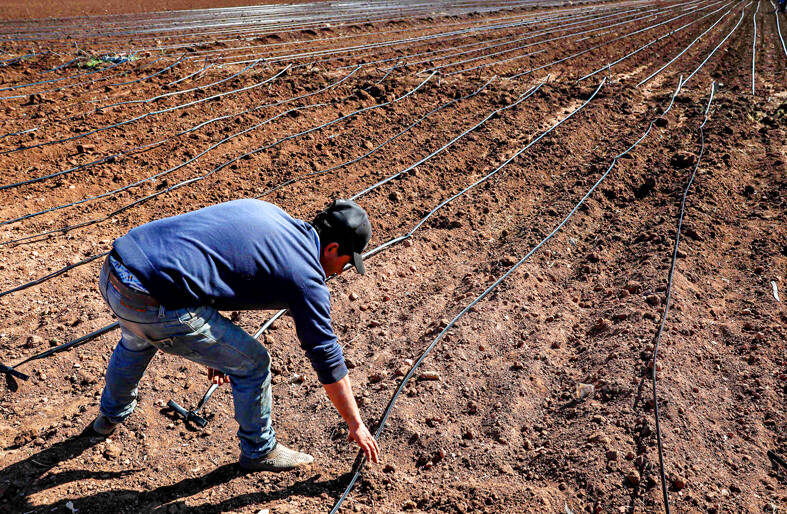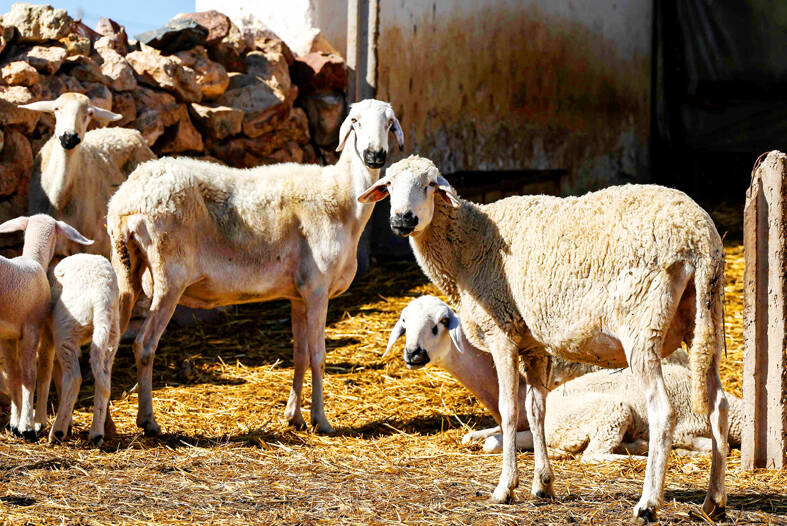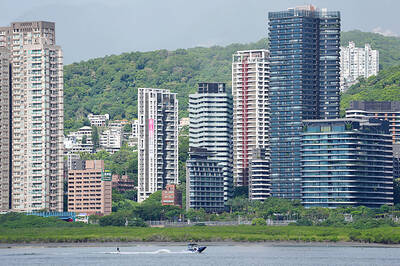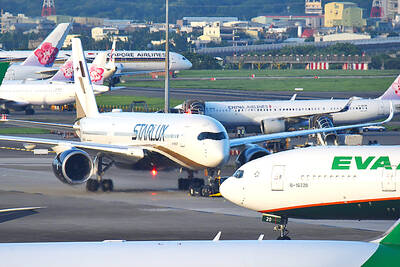Around this time every year, Moroccan wheat farmer Abderrahim Mohafid is usually preparing for his spring harvest, but this year his fields lie unusually bare.
On the road leading up to his hamlet in Berrechid province, Morocco’s historical breadbasket about 40km southeast of Casablanca, vast fields languish as the country grapples with its sixth consecutive year of drought.
“The harvest is already lost,” said Mohafid, 54, as he glanced at his 20-hectare field where almost nothing has grown. “Wheat should already be at 60 centimeters.”

Photo: AFP
In a neighboring village, Hamid Najem found himself in the same predicament.
His 52 hectares that have yielded soft wheat and barley in past years “are no longer good for anything,” the 50-year-old said. “We’ve never had such a tough year.”
More than 88 percent of Berrechid’s vast agricultural lands are not irrigated, with farmers relying instead on rain, according to Morocco’s agriculture ministry.

Photo: AFP
Yet so far this year, the North African country has seen only about half the rainfall it did during the same period last year, Moroccan Minister of Equipment and Water Nizar Baraka said.
This has occurred in parallel with temperatures in Morocco increasing by an average of 1.8 degrees Celsius compared with the period between 1981 and 2010, he added.
In recent weeks, Moroccan authorities have restricted the opening of hammams and car wash stations in several cities and prohibited the watering of golf courses or gardens with drinking water, as the country’s dams are only at 23 percent capacity, compared with around 32 percent last year.
The successive years of drought are “compromising” this agricultural season, agronomist Abderrahim Handouf said.
Fearing the effects of the prolonged water scarcity, farmers had already reduced the size of areas in which they sowed cereals, according to the expert.
In November last year, they had sown 2.3 million hectares compared to between 4 million and 5 million hectares on average in previous years, he said.
The situation, Handouf added, will have a “serious impact on the economy” of the country where a third of the population works in agriculture.
The sector also accounts for 14 percent of Morocco’s exports, with exported produce seen as more profitable than that sold in domestic markets.
Mohafid said he hoped to make up for losses in previous seasons by adapting new sowing techniques, such as planting seeds without plowing the field first, allowing the soil to preserve its natural humidity.
“The harvest is already lost, but I hope it will rain in February and March at least to have enough to feed the livestock,” he said.
For some larger-scale farmers, the prospects aren’t as gloomy, but irrigation has become essential.
Hamid Mechaal said he can count on irrigation to save his 140 hectares in the east of the province of Berrechid, where he grows wheat, carrots and potatoes.
“With drought, we are forced to irrigate at 85 percent, whereas before, irrigation was only complementary,” the farmer said.
Like 500 farmers in the region, he is supplied with a fixed allocation of 5,000 tonnes of water per hectare “to better manage” the coveted resource.
Morocco’s agricultural model — tunnel-visioned on exports for the past 15 years — is yet again faced with challenges at a time when the country sees “an absolutely declining water supply,” agronomist Mohamed Taher Srairi said.
It has nonetheless been focused on water-intensive crops, like carrots in Berrechid, he added.
The Food and Agriculture Organization (FAO) has similarly warned of a “disorderly intensification of irrigation” in Berrechid over the past two decades.
“Between 2007 and 2017, carrot production, for instance, increased nearly 500 percent,” the FAO said in a report in November last year, adding that the Berrechid aquifer was “one of the most depleted in Morocco.”
The North African country’s needs are estimated at more than 16 billion cubic meters of water, including 87 percent for the agricultural sector, but it has only had five billion cubic meters over the last five years, according to the water ministry.
“Agricultural policy should be reviewed from top to bottom,” Handouf said. “Today, I’m under the impression that the government is looking in one direction while reality is in the opposite direction.”

Taiwan’s rapidly aging population is fueling a sharp increase in homes occupied solely by elderly people, a trend that is reshaping the nation’s housing market and social fabric, real-estate brokers said yesterday. About 850,000 residences were occupied by elderly people in the first quarter, including 655,000 that housed only one resident, the Ministry of the Interior said. The figures have nearly doubled from a decade earlier, Great Home Realty Co (大家房屋) said, as people aged 65 and older now make up 20.8 percent of the population. “The so-called silver tsunami represents more than just a demographic shift — it could fundamentally redefine the

Businesses across the global semiconductor supply chain are bracing themselves for disruptions from an escalating trade war, after China imposed curbs on rare earth mineral exports and the US responded with additional tariffs and restrictions on software sales to the Asian nation. China’s restrictions, the most targeted move yet to limit supplies of rare earth materials, represent the first major attempt by Beijing to exercise long-arm jurisdiction over foreign companies to target the semiconductor industry, threatening to stall the chips powering the artificial intelligence (AI) boom. They prompted US President Donald Trump on Friday to announce that he would impose an additional

China Airlines Ltd (CAL, 中華航空) said it expects peak season effects in the fourth quarter to continue to boost demand for passenger flights and cargo services, after reporting its second-highest-ever September sales on Monday. The carrier said it posted NT$15.88 billion (US$517 million) in consolidated sales last month, trailing only September last year’s NT$16.01 billion. Last month, CAL generated NT$8.77 billion from its passenger flights and NT$5.37 billion from cargo services, it said. In the first nine months of this year, the carrier posted NT$154.93 billion in cumulative sales, up 2.62 percent from a year earlier, marking the second-highest level for the January-September

Asian e-commerce giant Shein’s (希音) decision to set up shop in a historic Parisian department store has ruffled feathers in the fashion capital. Anger has been boiling since Shein announced last week that it would open its first permanent physical store next month at BHV Marais, an iconic building that has stood across from Paris City Hall since 1856. The move prompted some French brands to announce they would leave BHV Marais, but the department store had already been losing tenants over late payments. Aime cosmetics line cofounder Mathilde Lacombe, whose brand was among those that decided to leave following